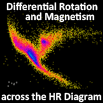Speaker
Gustavo Guerrero
(Solar Physics, HEPL, Stanford University)
Description
Solar and stellar activity is thought to be the result of the collective effects of
turbulent-rotating convection. It develops large-scale flow patterns like
differential rotation and meridional flows, induces the generation of magnetic fields
as well as enhances their diffusion. In this work we explore the first part of the
process,
namely, the physic governing the development of the large-scale flows. We performed
anelastic global simulations of rotating convection in a model whose stratification
resembles that of the solar interior.
The numerical models correspond to the so called implicit large-eddy simulations
since they capture the contribution of the small, non-resolved, scales through the
non-linear computation of the numerical viscosity. The amount of viscosity is the
minimal necessary to keep the system stable, so that the Reynolds number is maximized
for any resolution. We obtained two different regimes of rotation, with zonal flows
accelerated either in the direction of rotation (solar-like) or in the opposite
direction. Simulations with different rotation
rates and different convection strength indicate that the resulting pattern depends
on the ratio between buoyancy and Coriolis forces (i.e., the Rossby number). Thanks
to the presence of a strongly subadiabatic layer at the bottom of the domain, we have
been able to reproduce regions of strong radial shear similar to the solar
tachocline. Similarly, enhanced superadiabaticity at the top of the domain results in
the formation of a near-surface shear layer located mainly at lower latitudes. The
models develop a gradient of potential temperature at the base of the convection zone
and the stable region, however, it does not propagates
across the entire domain. Thus, the baroclinicity remains small and so the rotation
iso-contours align in cylinders in agreement to the Taylor-Proudman balance.
Simulations with different resolution are also presented and the convergence of the
sub-grid scale method is discussed.
Author
Gustavo Guerrero
(Solar Physics, HEPL, Stanford University)

